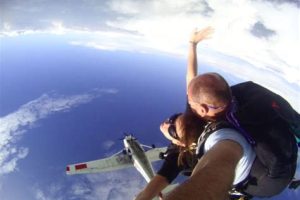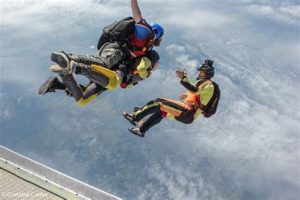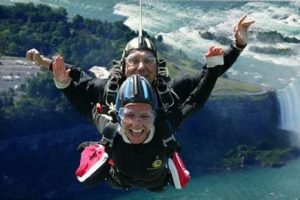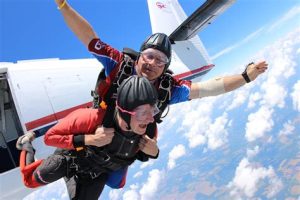Table of Contents
Discover the potential risks and injuries associated with tandem skydiving. Explore the importance of proper training, safety measures, and equipment to minimize the chances of accidents. Understand the precautions to take before embarking on this thrilling adventure. Stay informed and ensure a safe and enjoyable tandem skydiving experience.
Are you an adrenaline junkie looking for your next thrill? Tandem skydiving might just be the adventure you’ve been seeking. With its heart-pounding free fall, breathtaking views, and the rush of soaring through the sky, tandem skydiving offers an experience like no other. However, it’s important to be aware that, like any extreme sport, there is a risk of injuries involved. In this article, we will explore some of the potential tandem skydiving injuries that you should be cautious of before taking the leap.
Introduction
Welcome to this informative article about tandem skydiving injuries. While tandem skydiving is an exhilarating experience that allows participants to enjoy the thrill of freefall without extensive training, it is important to be aware of the potential risks involved. This article aims to provide you with valuable information on common injuries that can occur during tandem skydiving and how to prevent them. By following proper safety protocols and understanding the potential risks, you can ensure a safer and more enjoyable skydiving experience.
The Importance of Proper Training
Tandem skydiving, as the name suggests, involves jumping out of an aircraft while harnessed to an experienced instructor. While participants do not require extensive training, it is crucial to receive proper instructions before the jump. Adequate training will familiarize you with the equipment, safety procedures, and body positioning during the jump. Ignoring or neglecting proper training increases the risk of injuries.
Common Tandem Skydiving Injuries
Although tandem skydiving is generally considered safe, injuries can occur due to various factors. Some common injuries include:
1. Sprains and Strains
During landing, improper technique or a hard impact can lead to sprained or strained muscles and ligaments. It is essential to listen to your instructor’s advice on landing techniques and follow them closely to minimize the risk of such injuries.
2. Fractures and Bone Injuries
In rare cases, a hard landing or collision with another skydiver or object can result in fractures or other bone injuries. These injuries typically occur when safety protocols are not followed or in unpredictable situations. It is crucial to trust your instructor and their expertise to avoid such incidents.
3. Dislocations
Dislocations can occur when the joint is forced out of its normal position upon landing. Proper body positioning during the jump and following landing instructions will reduce the risk of dislocations. Instructors are trained to handle emergency situations and will guide you on how to land safely.
4. Cuts and Bruises
Minor cuts and bruises can occur due to contact with equipment or rough landings. Wearing appropriate clothing and protective gear can help minimize the severity of these injuries. Additionally, following landing instructions and being aware of your surroundings will further reduce the risk.
Preventing Tandem Skydiving Injuries
While there are inherent risks involved in any extreme sport, including tandem skydiving, there are steps you can take to prevent injuries:
1. Choose a Reputable Skydiving Center
Select a skydiving center that prioritizes safety, has experienced instructors, and maintains their equipment properly. Research reviews and ask for recommendations to ensure you choose a reliable and reputable facility.
2. Listen to Your Instructor
Pay close attention to the pre-jump briefing and follow all instructions provided by your instructor. They have extensive knowledge and experience to keep you safe during the entire skydiving process.
3. Wear Appropriate Gear
Ensure you are wearing the appropriate clothing and gear for the jump. This includes a well-fitting jumpsuit, goggles, and a properly adjusted harness. Wearing comfortable, closed-toe shoes is also essential to prevent foot injuries during landing.
4. Communicate Any Concerns
If you have any pre-existing medical conditions or concerns, inform your instructor beforehand. They will be able to provide you with appropriate guidance and ensure extra precautions are taken if necessary.
5. Follow Proper Body Positioning
During the jump and landing, maintain the correct body position as instructed by your instructor. This will help distribute the impact evenly and reduce the risk of injuries.
Conclusion
Tandem skydiving injuries can occur, but with proper training, adherence to safety protocols, and choosing a reputable skydiving center, you can significantly minimize the risk. Remember, tandem skydiving can be an incredible experience, and by taking precautions and following instructions, you can enjoy it while keeping yourself safe. Always prioritize your safety and the safety of those around you to ensure a memorable and injury-free skydiving adventure.
Introduction
Welcome to the use instructions for understanding the potential injuries associated with tandem skydiving. These guidelines will provide you with an overview of common injuries that may occur during tandem skydiving and how to minimize the risks.
General Safety Considerations
a. Awareness and Education
Awareness and education are crucial when it comes to tandem skydiving. Understanding the potential risks and how to stay safe can significantly reduce the chances of injury.
b. Following Instructions
Always follow the instructions provided by your tandem instructor and listen attentively during the pre-jump briefing to ensure the proper execution of safety procedures.
c. Physical Fitness and Medical Conditions
Maintain a good level of physical fitness and inform your instructor of any pre-existing medical conditions that may affect your skydiving experience.
Equipment Malfunction
a. Remaining Calm
In the event of an equipment malfunction, such as a parachute malfunction or harness failure, it is vital to keep calm and follow the instructions provided by your instructor.
b. Emergency Procedures
Pay attention during the pre-jump briefing to understand the emergency procedures and how to use the reserve parachute system if necessary.
c. Equipment Inspections
Regular inspections and maintenance of the equipment are essential to minimize the risks associated with malfunctions.
Hard Landings
a. Causes and Injuries
Hard landings can occur if the descent is not properly controlled or due to unforeseen factors like wind gusts. This can lead to injuries such as sprains, fractures, or even concussions.
b. Reducing the Risk
To reduce the risk of a hard landing, it is crucial to maintain the correct body position, follow the instructions given by your instructor, and use proper landing techniques.
c. Landing Process
Your instructor will guide you throughout the landing process, including the instruction to bend your knees and maintain a slight forward motion during touchdown.
Upright Body Position Injuries
a. Importance of Body Positioning
Maintaining an upright body position during freefall is vital for both safety and enjoyment. Deviating from the correct body position may cause discomfort or injury to the neck, spine, or joints.
b. Listening to Instructor’s Advice
Listen attentively to your instructor’s advice on body positioning and practice proper techniques to avoid unnecessary strain during freefall.
c. Relaxation and Guidance
Staying relaxed and following your instructor’s guidance will help you maintain stability while reducing the risk of injuries related to incorrect body positioning.
Collision with Objects or Other Skydivers
a. Uncommon Incidents
While highly uncommon, collisions with other skydivers or objects during freefall can result in serious injuries. Maintaining situational awareness and adhering to safety guidelines significantly reduce the likelihood of such incidents.
b. Navigating Air Traffic
Ensure you are properly trained on how to navigate through air traffic and avoid collisions, including understanding hand signals and keeping a safe distance from other skydivers.
c. Following Instructor’s Guidance
Always follow the instructions given by your instructor and their guidance during freefall to minimize the risk of collisions.
Wind-Related Injuries
a. Challenges and Injuries
Strong wind conditions can pose challenges during skydiving, potentially resulting in injuries. These may include blows to the head or body, disorientation, or difficulty maintaining balance.
b. Weather Conditions and Safety Measures
Regularly checking weather conditions before your jump is essential to avoid unfavorable conditions. Listen to your instructor’s advice on wind-related safety measures, such as adjusting the jump altitude or rescheduling the jump if needed.
c. Body Position and Core Strength
Adapting your body position, maintaining a stable arch, and keeping a strong core can assist in minimizing the impact of strong winds during the skydiving experience.
Motion Sickness
a. Sensory Overload
Some individuals may experience motion sickness or vertigo during skydiving due to sensory overload. Symptoms may include nausea, dizziness, or disorientation.
b. Prevention and Relief
To prevent or alleviate motion sickness, avoid consuming heavy meals or alcohol before the jump, stay hydrated, and consider over-the-counter medications specifically formulated for motion sickness prevention.
c. Communication with Instructor
Communicate any sensations or discomfort experienced during the skydive to your instructor to ensure appropriate support and guidance are provided.
Remember, tandem skydiving can be an exhilarating experience when proper safety measures are taken, and instructions are followed diligently. Adhering to the guidelines outlined in these instructions will help ensure a safe and enjoyable tandem skydiving adventure.
Point of View: Tandem Skydiving Injuries
In this guide, we will provide you with important instructions and information regarding tandem skydiving injuries. It is crucial to be aware of the potential risks associated with this extreme sport, as well as the precautions that can be taken to minimize the chances of injury.
-
Understand the Risks: Tandem skydiving, like any adventure sport, carries inherent risks. Participants must be aware that injuries can occur due to various factors such as equipment malfunction, human error, or unforeseen circumstances. It is important to acknowledge and accept these risks before engaging in tandem skydiving.
-
Choose a Certified Drop Zone: Selecting a reputable drop zone is essential to ensure a safe skydiving experience. Look for a facility that is certified by recognized skydiving organizations, as they adhere to strict safety standards and regulations. This significantly reduces the likelihood of accidents and injuries.
-
Follow Instructor’s Guidance: During the tandem skydive, it is crucial to listen carefully to your instructor and follow their instructions precisely. They have extensive training and experience, and their guidance is essential for your safety. Ignoring or disregarding their instructions may increase the risk of injury.
-
Wear Appropriate Gear: Always wear the proper skydiving gear provided by the drop zone, including a well-fitted harness, goggles, and a helmet. Ensuring that all equipment is in good condition and properly adjusted is vital to minimize potential injuries. Do not hesitate to ask your instructor for assistance if you have any concerns about your gear.
-
Maintain Physical Fitness: Tandem skydiving can be physically demanding. It is important to be in good overall health and have a reasonable level of fitness before attempting a jump. Certain medical conditions or physical limitations may increase the risk of injury, so it is crucial to inform your instructor about any relevant health issues.
-
Land Properly: The landing phase of a tandem skydive requires proper technique to minimize the risk of injury. Follow your instructor’s instructions on how to position your body and where to place your feet during touchdown. Maintain a bent-knee stance and allow your instructor to take the brunt of the impact, as they are trained to handle landings safely.
-
Report Any Discomfort or Pain: If you experience any discomfort, pain, or unusual sensations during the tandem skydive, communicate this immediately to your instructor. They will assess the situation and take appropriate action to prevent further injury. Do not ignore or downplay any physical symptoms, as they may be indicative of a potential problem.
-
Post-Jump Care: After completing a tandem skydive, it is essential to follow any post-jump care instructions provided by your instructor. This may include avoiding certain activities or applying ice to specific areas. Adhering to these guidelines will help minimize any post-jump soreness or potential injuries.
-
Learning from Incidents: In the unfortunate event of an injury during tandem skydiving, it is crucial to report the incident to the drop zone management. This allows them to investigate and take necessary measures to prevent similar incidents in the future. Learning from past experiences helps improve safety standards within the sport.
By following these instructions and guidelines, you can significantly reduce the risk of tandem skydiving injuries. Remember, safety should always be your top priority when engaging in extreme sports like skydiving. Enjoy the thrilling experience while taking appropriate precautions to ensure a safe and memorable adventure.
Thank you for taking the time to visit our blog and learn more about tandem skydiving injuries. We understand that this topic can be concerning, but we want to assure you that safety is our utmost priority in the world of skydiving. In this closing message, we will recap some of the key points discussed in this article and provide you with important instructions to keep in mind if you decide to embark on a tandem skydiving adventure.
First and foremost, it’s crucial to acknowledge that any adventurous activity comes with inherent risks, and tandem skydiving is no exception. While the thought of jumping out of a perfectly good airplane may seem intimidating, it’s essential to remember that skydiving centers prioritize safety above all else. They adhere to strict regulations and employ highly trained instructors who have extensive experience in managing potential risks.
Throughout this article, we have covered various tandem skydiving injuries that can occur, such as sprains, strains, and fractures. It’s important to note that while these injuries are possible, they are relatively rare, especially when proper safety measures are followed. Skydiving centers invest heavily in maintaining their equipment, ensuring that parachutes are regularly inspected and certified. Additionally, instructors are trained to assess weather conditions and make informed decisions regarding jump cancellations or delays in the event of unfavorable conditions.
Instructions for anyone considering a tandem skydiving experience, it is essential to choose a reputable skydiving center that prioritizes safety. Do thorough research, read reviews, and ask questions about their safety protocols. Once you have selected a center, follow their instructions carefully and communicate openly with your instructor. They will provide you with detailed guidance on how to position your body during the jump and landing, as well as any other necessary precautions.
In conclusion, tandem skydiving injuries, while possible, are relatively rare when proper safety measures are followed. By choosing a reputable skydiving center, communicating with your instructor, and adhering to their instructions, you can minimize the risks associated with this thrilling adventure. So, if you have always dreamed of experiencing the exhilarating feeling of freefalling through the sky, don’t let the fear of injuries hold you back. Take the necessary precautions, trust in the expertise of your instructors, and embark on an unforgettable tandem skydiving journey.
Thank you once again for visiting our blog, and we hope that the information provided has been helpful in addressing any concerns you may have had about tandem skydiving injuries. Remember, safety should always be the top priority, and with the right precautions in place, you can enjoy the thrill of skydiving while minimizing any potential risks.
.
People also ask about Tandem Skydiving Injuries:
-
What are the common injuries associated with tandem skydiving?
- Minor bruises or scrapes from landing
- Sprained ankles or wrists
- Whiplash or strains from sudden movements
- Dislocations or fractures in rare cases
- Injuries caused by parachute malfunctions (extremely rare)
-
How can I prevent injuries during a tandem skydive?
- Listen attentively during the pre-jump briefing and ask any questions you may have.
- Wear appropriate clothing and gear, including a well-fitted harness and goggles.
- Follow proper body positioning during the jump and landing, as instructed by your instructor.
- Don’t attempt any stunts or maneuvers without proper training.
- Trust your instructor’s expertise and guidance throughout the entire process.
-
Are there any age or health restrictions for tandem skydiving?
- Weight limits to ensure the safety of the equipment (usually around 220-250 pounds or 100-113 kilograms).
- No recent surgeries or injuries that may affect your ability to skydive safely.
- No heart conditions, epilepsy, or other serious medical conditions.
- Some centers may require a doctor’s certificate of fitness for certain individuals.
-
What should I do if I get injured during a tandem skydive?
Tandem skydiving is generally considered safe, but there is still a risk of injuries. Some common injuries that can occur during tandem skydiving include:
To minimize the risk of injuries during a tandem skydive, it is important to follow the instructions provided by your instructor:
Yes, there are certain age and health restrictions for tandem skydiving. These restrictions may vary depending on the skydiving center and country regulations. Generally, participants must be at least 18 years old and in good overall health. Some common restrictions include:
If you sustain an injury during a tandem skydive, it is important to seek immediate medical attention. Notify your instructor or the staff at the skydiving center about your injury so they can assist you accordingly. They will evaluate the situation and provide necessary first aid or arrange for further medical assistance if required.






